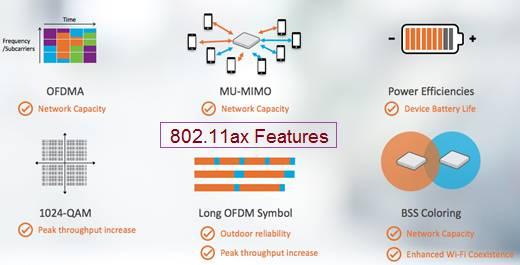802.11ax MCS Table and Rates Explained
Advertisement
This page provides information on the 802.11ax MCS Table, detailing various 802.11ax MCS rates. The 802.11ax MCS table includes MCS0, MCS1, MCS2, MCS3, MCS4, MCS5, MCS6, MCS7, MCS8, MCS9, MCS10 and MCS11.
Introduction
The 802.11ax MCS (Modulation and Coding Scheme) table is a crucial reference for optimizing Wi-Fi 6 network performance, as it defines the data rates achievable based on modulation type, coding rate and spatial streams. This table enables network engineers and device manufacturers to make informed decisions on transmission parameters, balancing speed, reliability and power efficiency.
What is WLAN 802.11ax?
- IEEE 802.11ax is the 6th generation of WiFi technology, commonly known as WiFi 6.
- It’s also referred to as HEW (High Efficiency WLAN) due to its high-efficiency performance.
- 802.11ax was developed to address the limitations of 802.11ac, such as contention-based uplink access.
- 802.11ax offers improved efficiency, network capacity, performance, and a better user experience with reduced latency.

Image Courtesy: Ruckus Networks
Features of 802.11ax:
- Higher modulation scheme (1024-QAM)
- Increased number of OFDM subcarriers in a symbol or long OFDM symbol
- Multiplexing users using MU-MIMO in both uplink and downlink directions
- Beamforming and OFDMA techniques
- Supports 8 simultaneous MU-MIMO streams
- Contention-free uplink scheduling
- BSS color codes
- Operates on both 2.4 GHz and 5 GHz bands
802.11ax MCS Table | 802.11ax MCS Rates
The following table presents the 802.11ax MCS rates for a short guard interval (800 ns). “SS” represents the Number of Spatial Streams. “8 xSS” refers to eight number of spatial streams. The data rates in the table are in Mbps.
| MCS | Rate | Modulation and Code Rate | 20 MHz, 1 xSS | 20 MHz, 2 xSS | 20 MHz, 4 xSS | 20 MHz, 8 xSS | 40 MHz, 1 xSS | 40 MHz, 2 xSS | 40 MHz, 4 xSS | 40 MHz, 8 xSS | 80 MHz, 1 xSS | 80 MHz, 2 xSS | 80 MHz, 4 xSS | 80 MHz, 8 xSS | 160 MHz, 8 xSS |
|---|---|---|---|---|---|---|---|---|---|---|---|---|---|---|---|
| MCS0 | BPSK 1/2 | 8.6 | 17.2 | 34.4 | 68.8 | 17.2 | 34.4 | 68.8 | 137.6 | 36.0 | 72.1 | 144.1 | 288.2 | ||
| MCS1 | QPSK-1/2 | 17.2 | 34.4 | 68.8 | 137.6 | 34.4 | 68.8 | 137.6 | 275.3 | 72.1 | 144.1 | 288.2 | 576.5 | ||
| MCS2 | QPSK-3/4 | 25.8 | 51.6 | 103.2 | 206.5 | 51.6 | 103.2 | 206.5 | 412.9 | 108.1 | 216.2 | 432.4 | 864.7 | ||
| MCS3 | 16QAM 1/2 | 34.4 | 68.8 | 137.6 | 275.3 | 68.8 | 137.6 | 275.3 | 550.6 | 144.1 | 288.2 | 576.5 | 1152.9 | ||
| MCS4 | 16QAM 3/4 | 51.6 | 103.2 | 206.5 | 412.9 | 103.2 | 206.5 | 412.9 | 825.9 | 216.2 | 432.4 | 864.7 | 1729.4 | ||
| MCS5 | 64QAM 2/3 | 68.8 | 137.6 | 275.3 | 550.6 | 137.6 | 275.3 | 550.6 | 1101.2 | 288.2 | 576.5 | 1152.9 | 2305.9 | ||
| MCS6 | 64QAM 3/4 | 77.4 | 154.9 | 309.7 | 619.4 | 154.9 | 309.7 | 619.4 | 1238.8 | 324.3 | 648.5 | 1297.1 | 2594.1 | ||
| MCS7 | 64QAM 5/6 | 86.0 | 172.1 | 344.1 | 688.2 | 172.1 | 344.1 | 688.2 | 1376.5 | 360.3 | 720.6 | 1441.2 | 2882.4 | ||
| MCS8 | 256QAM 3/4 | 103.2 | 206.5 | 412.9 | 825.9 | 206.5 | 412.9 | 825.9 | 1651.8 | 432.4 | 864.7 | 1729.4 | 3458.8 | ||
| MCS9 | 256QAM 5/6 | 114.7 | 229.4 | 458.8 | 917.6 | 229.4 | 458.8 | 917.6 | 1835.3 | 480.4 | 960.8 | 1921.6 | 3843.1 | ||
| MCS10 | 1024QAM 3/4 | 129.0 | 258.1 | 516.2 | 1032.4 | 258.1 | 516.2 | 1032.4 | 2064.7 | 540.4 | 1080.9 | 2161.8 | 4323.5 | ||
| MCS11 | 1024QAM 5/6 | 143.4 | 286.8 | 573.5 | 1147.1 | 286.8 | 573.5 | 1147.1 | 2294.1 | 600.5 | 1201.0 | 2402.0 | 4803.9 | 9607.8 |
Conclusion
By leveraging the 802.11ax MCS table, implementations can dynamically adjust modulation schemes based on channel conditions, ensuring optimal throughput while maintaining robust connectivity. The flexibility provided by various MCS levels helps maximize spectral efficiency and network capacity, making it essential for achieving the high performance goals of Wi-Fi 6 in dense and demanding wireless environments.
Advertisement
 RF
RF


